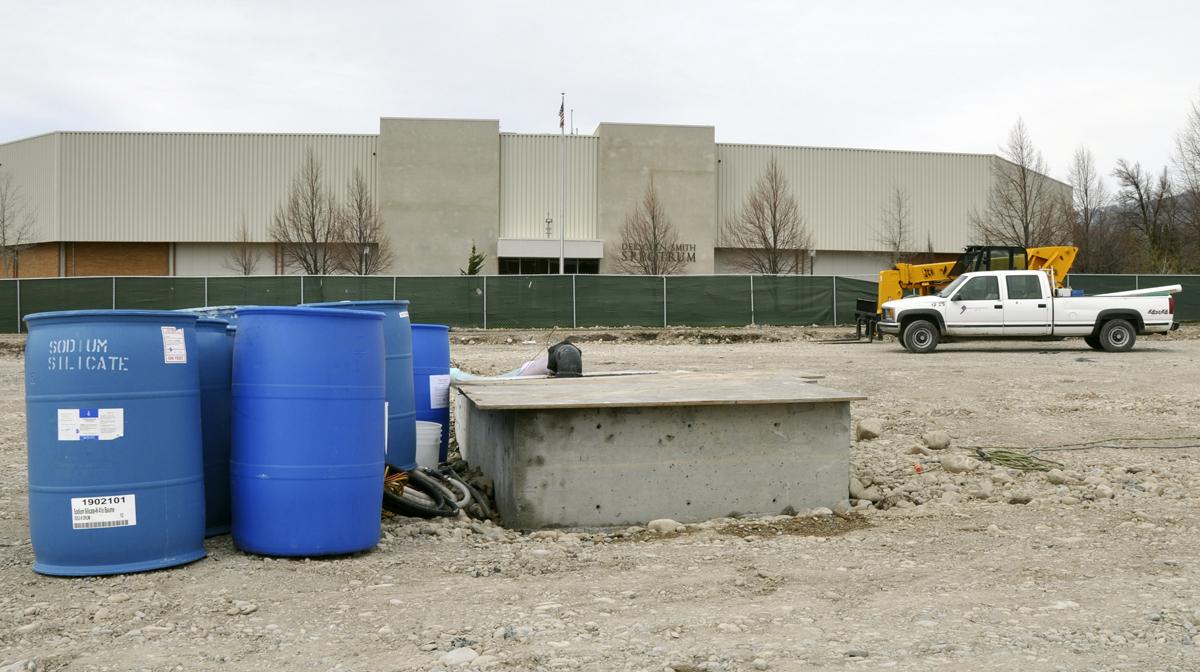Crews finish water tank construction
With the completion of a new subterranean thermal energy storage tank, a gaping crater in a field adjacent the HPER Building has been filled, and now construction crews will begin work on the Aggie Legacy Fields.
The tank is meant to improve USU’s air-conditioning system while conserving energy, said Ben Berrett, director of planning, design and construction on campus. The university currently chills water at a central location and pumps it to most of the buildings on campus to cool the air, he said.
Berrett said to save money the tank will cool water at night for use in the daytime.
“We get charged a premium for using power during the peak of the day,” Berrett said. “Essentially, power is more expensive when you need it for air conditioning.”
The 130-foot diameter and 35-foot deep tank can hold approximately 2 million gallons, Berrett said.
Another advantage of chilling water at night is increased efficiency, so less electricity is needed to chill the water, Berrett said.
The tank could also help the university in the event of a power outage, Berrett said.
“There are some operational advantages,” he said. “If you have a momentary power outage during the day – or if one of our chillers fails during the day – it becomes a large buffer.”
Computer servers and data centers could be kept at operational temperature in the event of a power outage, something that would be difficult with more conventional air-conditioning methods, Berrett said.
Installation of the tank cost $2.6 million, said Lorin Mortensen, a mechanical engineer for USU Facilities and tank project coordinator.
The tank should save the school about $2.6 million over the course of about 20 years, according to estimates, Mortensen said. However, since energy costs are difficult to predict over a 20-year span, that estimate may not reflect actual savings, he added.
“That’s a very theoretical number,” Mortensen said. “If you’re looking at replacing your lights with higher efficiency lights, you know pretty well what electric prices are going to be in two years. They’re going to be close. But in 20 years, are we going to be on coal, or are we going to be on solar or wind or nuclear? A lot can change in electric prices in 20 years.”
Due to the methods and materials used in its construction, the TES tank may not need replacement or significant repair for several decades, Berrett said.
“This is a real high-quality structure,” he said. “We may get to a point where we want to add additional ones, certainly, but I think this tank could last 100 years.”
The HPER Field was chosen as the tank’s location for many reasons, Berrett said. The field is close to the utility tunnel connecting the cooling plant to many campus buildings, and Campus Recreation officials have discussed improving the field anyway, he said.
Construction crews have buried the tank beneath the HPER Field. Beginning next week, another contractor will begin preparation to install artificial turf for the Aggie Legacy Fields.
Much of the HPER Field has been unavailable for student use during the tank’s installation, impacting USU’s intramural sport programs, said JP Parrish, event coordinator for Campus Recreation.
For nearly a year, the tank project effectively reduced field space available for club sport practices and intramural events, he said. Prior to the tank’s installation, other construction projects have also limited HPER Field availability, Parrish said, citing the example of a sewer pipe installation for the Emma Eccles Jones Early Childhood Education and Research Center.
“It’s been three years that we’ve had reduced or no functionality of that field,” Parrish said.
Despite the decrease in space available for intramural and club sports, the number of students wishing to participate has gone up, Parrish said.
“With that demand, we should have been expanding and not reducing the amount of field space for intramurals,” Parrish said. “Semester after semester we’ve had to turn students away.”
Almost 3,000 students participated in intramural sports in the 2011-2012 schoolyear, down 2,800 from the previous year, said intramural coordinator Jesse Parker.
The Aggie Legacy Fields project, funded by students and approved in the 2012 ASUSU elections, will help Campus Recreation keep up with demand for field space.
Since the new field will include lighting and no need for irrigation, intramural activities can be scheduled later in the evening, Parrish said. The turf installation should be complete by the start of fall semester, he said.
– steve.kent@aggiemail.usu.edu

